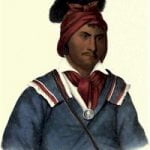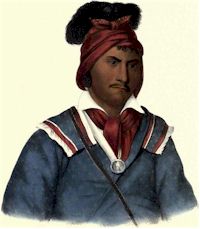
Black Dirt
Principal Seminole War Chief
This distinguished individual was at one time the principal war chief of the Seminoles, but being friendly to the United States, was superseded in that post by Holato Mico, the Blue King. His name, Foke Luste Hajo, signifies black craggy clay, but he is usually called Black Dirt, an epithet which seems to have no reference to his character, for he is described as a brave and high-minded man, of more than ordinary abilities.
He was one of the chiefs who assisted at the council of Payne’s Landing, and assented to the celebrated treaty of which the results have been so disastrous to the country, and so ruinous to the Seminoles; and he was one of the seven who were appointed to visit and explore the country offered to his people for their future residence. His associates were Holata Amathla, Jumper, Charley Amathla, Coa Hajo, Arpiucki, and Yaha Hajo. Having examined and approved the country, the delegation proceeded to ratify the treaty of Payne’s Landing, at Fort Gibson, on the 28th of March, 1833. This was one of the several fatal mistakes committed in the course of this unfortunate negotiation; for the chiefs were only deputed to examine the country, and should have reported the result of their inquiries to a council of the nation, who alone were competent to ratify the treaty. Colonel Gadsden, the commissioner who negotiated the treaty, in a letter to the Secretary of War, says: ” There is a condition prefixed to the agreement, without assenting to which, the Florida Indians most positively refused to negotiate for their removal west of the Mississippi. Even with the condition annexed, there was a reluctance which with some difficulty was overcome on the part of the Indians, to bind themselves by any stipulations before a knowledge of the facts and circumstances would enable them to judge of the advantages or disadvantages of the disposition the government of the United States wished to make of them. They were finally induced, however, to assent to the agreement.”
The same gentleman remarks further: ” The payment for property alleged to have been plundered, was the subject most press ed by the Indians, and in yielding to their wishes on this head, a limitation has been fixed in a sum, which I think, however, will probably cover all demands which can be satisfactorily proved. Many of the claims are for Negroes, said to have been enticed away from their owners, during the protracted Indian disturbances, of which Florida has been for years the theater. The Indians allege that the depredations have been mutual, that they have suffered in the same degree, and that most of the property claimed, was taken as reprisal for property of equal value lost by them. They could not, therefore, yield to the justice of restitution solely on their part; and probably there was no better mode of terminating the difficulty than by that provided for in the treaty now concluded. The final ratification of the treaty will depend upon the opinion of the seven chiefs selected to explore the country west of the Mississippi river. If that corresponds with the description given, or is equal to the expectations formed of it, there will be no difficulty on the part of the Seminoles.”
The mistake made by the agents of our government, in accepting the ratification of an important treaty, by a few chiefs, instead of requiring the action of the whole Seminole nation, properly convened in council, was a fatal one for the country.
We have stated, in another place, the conduct of this chief at the council held on the 23d of April, 1835, where he boldly and eloquently advocated the treaty of Payne’s Landing. We find him also assisting at a council on the 19th of August, in the same year and still adhering firmly to the pacific policy which he had, from the first, embraced.
At the close of the year 1835, a general council of the Seminoles was held, at which they resolved to retain possession of their country at all hazards, and condemned all who opposed their views to death. This was in effect a declaration of war; and all who had taken sides with the United States were admonished by it to seek safety in flight. Accordingly, Holata Amathla, Otulke Amathla, Foke Luste Hajo, Conhatkee Mico, Foshutchee Mico, and about four hundred and fifty of their followers, fled to Fort Brook, and encamped under the protection of its guns. Since that time this chief has remained with our troops, using his best efforts to put an end to this unhappy war, which is rapidly wasting away the strength of the Seminoles, while to the American army it has been a field of gallant and untiring effort, filled with daring and brilliant events, but equally fraught with disaster and fruitless of good results.


